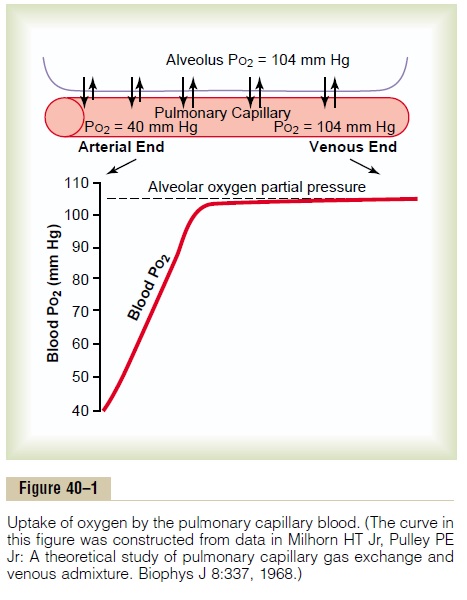Chapter: Medical Physiology: Transport of Oxygen and Carbon Dioxide in Blood and Tissue Fluids
Diffusion of Oxygen from the Alveoli to the Pulmonary Capillary Blood
Diffusion of Oxygen from the Alveoli to the Pulmonary Capillary Blood
The top part of Figure 40–1 shows a pulmonary alveolus adjacent to a pul-monary capillary, demonstrating diffusion of oxygen molecules between the alveolar air and the pulmonary blood. The PO2 of the gaseous oxygen in the alveolus averages 104 mm Hg, whereas the PO2 of the venous blood entering the pulmonary capillary at its arterial end averages only 40 mm Hg because a large amount of oxygen was removed from this blood as it passed through the periph-eral tissues. Therefore, the initial pressure difference that causes oxygen to diffuse into the pulmonary capillary is 104 – 40, or 64 mm Hg. In the graph at

the bottom of the figure, the curve shows the rapid rise in blood PO2 as the blood passes through the capillary; the blood PO2 rises almost to that of the alveolar air by the time the blood has moved a third of the distance through the capillary, becoming almost 104 mm Hg.
Uptake of Oxygen by the Pulmonary Blood During Exercise. During strenuous exercise, a person’s body may require as much as 20 times the normal amount of oxygen. Also, because of increased cardiac output during exercise, the time that the blood remains in the pulmonary capillary may be reduced to less than one half normal. Yet, because of the great safety factor for diffusion of oxygen through the pulmonary mem-brane, the blood still becomes almost saturated with oxygen by the time it leaves the pulmonary capillaries. This can be explained as follows.
First, it was pointed out that the dif-fusing capacity for oxygen increases almost threefold during exercise; this results mainly from increased surface area of capillaries participating in the diffusion and also from a more nearly ideal ventilation-perfu-sion ratio in the upper part of the lungs.
Second, note in the curve of Figure 40–1 that under nonexercising conditions, the blood becomes almost saturated with oxygen by the time it has passed through one third of the pulmonary capillary, and little additional oxygen normally enters the blood during the latter two thirds of its transit. That is, the blood normally stays in the lung capillaries about three times as long as necessary to cause full oxygenation.
Therefore, during exercise, even with a shortened time of exposure in the capillaries, the blood can still become fully oxygenated, or nearly so.
Related Topics